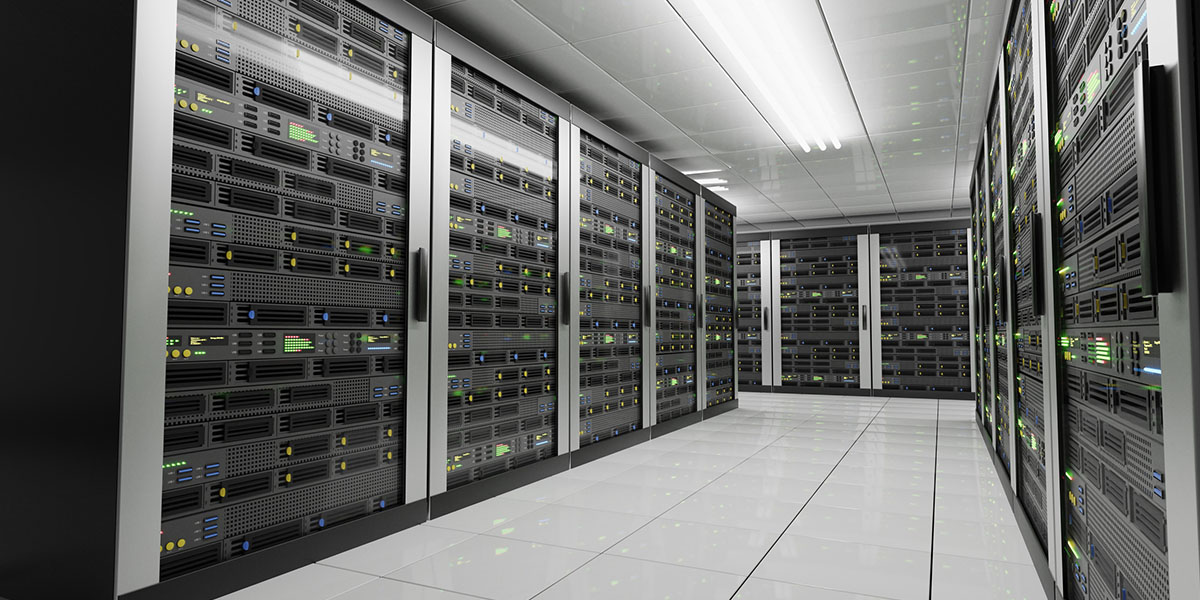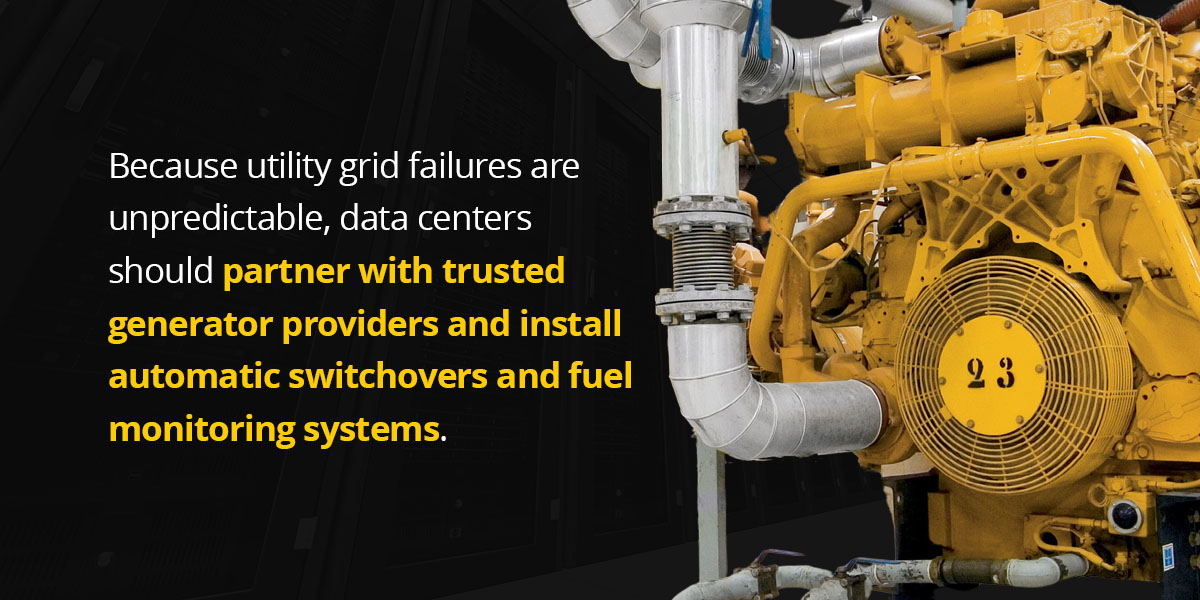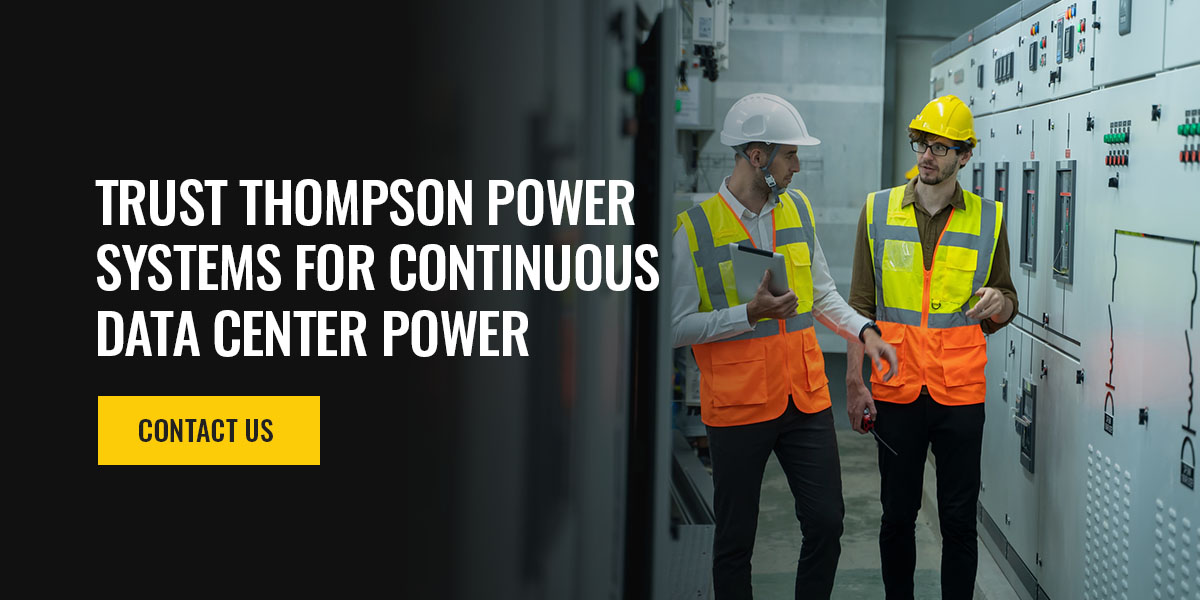

Data centers are the backbone of our digital world, storing vast amounts of data that powers online services, from banking and health care to streaming platforms. As such, maintaining consistent uptime is a must. However, according to a 2024 data center outage analysis, power issues account for 52% of impactful data outages, making them the leading cause of data center downtime.
Dependable power is important in data centers because it keeps operations running, protects data integrity, and supports 24/7 service availability. Learn how data centers manage power distribution, from the core infrastructure to the types of power they use. We’ll also review key strategies for preventing outages and ensuring data center reliability.
Understanding how electricity reaches IT facilities helps explain data center power distribution. This originates from the utility feed all the way to the data center’s critical infrastructure. Here’s how electricity is delivered to data centers:
Data centers get power from utility companies transmitting from generation plants such as hydroelectric, nuclear, or renewable sources over high-voltage transmission lines. Transformers at the source increase this voltage significantly, enabling efficient transmission across long distances.
These substations then begin stepping the voltage down, preparing it for safe and manageable delivery to business establishments.
Once electricity reaches the data center from the utility grid, it’s typically delivered at a medium voltage level. Before the power is used by IT equipment, the voltage level must be decreased further by on-site transformers to a lower, more usable voltage.
These final voltage conversions ensure that each system operates within the safe power range. If the voltage isn’t precisely managed, it could lead to overheating, inefficiency, or equipment failure, especially in high-density environments.
After voltage is converted to the appropriate level, electricity is distributed throughout the facility through a network of power distribution units (PDUs). Data centers get power from devices that direct electricity to servers, networking equipment, and storage systems located within server racks.
Remote power panels (RPPs) act as intermediaries between the PDUs and individual racks, offering flexibility in routing and monitoring. Metered PDUs can also provide real-time power usage insights, allowing data center operators to optimize load balancing and energy efficiency.
Within the data center, power undergoes final conversion steps to ensure IT equipment receives the voltage it requires.
Specialized conditioning devices, such as voltage regulators, filters, and uninterruptible power supplies (UPS), help refine the electrical output by eliminating noise, voltage fluctuations, and harmonics. These systems work together to deliver a clean and stable power supply that protects sensitive hardware and prevents downtime.
UPS systems and efficient data center backup generators also maintain stable power flow during outages or fluctuations, ensuring smooth and continuous operations.
A data center’s infrastructure contains the essential hardware and systems that keep facilities running. Core components include:
Supporting this digital ecosystem are cabling and rack systems that organize and interconnect equipment within the physical space, with management platforms that monitor performance, availability, and configuration to maintain operational efficiency.
A well-designed infrastructure ensures data centers stay online with minimal interruption. This requires careful planning of power distribution, physical layout, and system monitoring to anticipate failures before they affect critical services. Without this alignment, even the most advanced facility risks costly downtime.
Redundant power paths are essential in modern data centers. By connecting IT equipment to dual power feeds, UPS systems, and isolating electrical faults, redundancy keeps operations running and prevents significant downtime. This layered approach is important for maintaining uptime, especially during unexpected power disruptions.
Data centers may rely on a combination of alternating current (AC) and direct current (DC) to power operations. AC is delivered from the power grid and is commonly used to operate critical systems such as networking devices, servers, storage arrays, and cooling units.
DC flows in one continuous direction and is typically used within power conversions, battery backup systems, and powering components like microprocessors and UPS systems. While AC is more widely accessible and cost-effective, DC power offers higher efficiency and can help reduce energy consumption.
In addition to the type of current, data centers must also consider the power phase. Single-phase AC delivers one oscillating wave and is usually enough for residential and small business use. However, it’s not ideal for large-scale operations. Meanwhile, three-phase AC delivers three alternating waves in a sequence, providing a more stable and efficient flow of electricity. This makes it suited for the high-performance requirements of data centers.
Three-phase power is a preferred choice in data center environments because it reduces energy loss, balances power loads, and minimizes heat generation. This continuous and even distribution of power ensures that data centers stay online more reliably, even under demanding conditions.

To minimize downtime, data centers are built with layers of backup power systems, including UPS and standby generators. As mentioned earlier, these systems activate instantly during a power disruption, keeping critical equipment running without interruption. Because utility grid failures are unpredictable, data centers should partner with trusted generator providers and install automatic switchovers and fuel monitoring systems.
However, having backup power isn’t enough. Equipment must work reliably when needed. To address this, data centers must prioritize routine testing and maintenance. Regular checks help ensure generators and UPS units function properly in real emergencies. Also, consider implementing switchgear preventive maintenance to reduce hazards and support continuous operations. This proactive approach safeguards uptime and provides peace of mind when outages occur.
Besides using reliable generators, the following strategies can help your data center facility avoid downtime:

Ensure uninterrupted power distribution for your data center with dependable equipment and a proactive approach. Invest in high-performance power solutions from Thompson Power Systems. We provide heavy-duty Cat® generators for data centers, including gas, diesel, and mobile generator sets, as well as cutting-edge microgrid technology for renewable energy generation.
Thompson Power Systems has provided critical power solutions with dedicated customer service to northwest Florida and Alabama for over 65 years. Our experienced team delivers expert generator installation and comprehensive maintenance services. We also offer extended service coverage for new, used, and overhauled equipment to safeguard your investment.
Contact us today to discuss your specific needs and improve your data center’s uptime for successful operations.